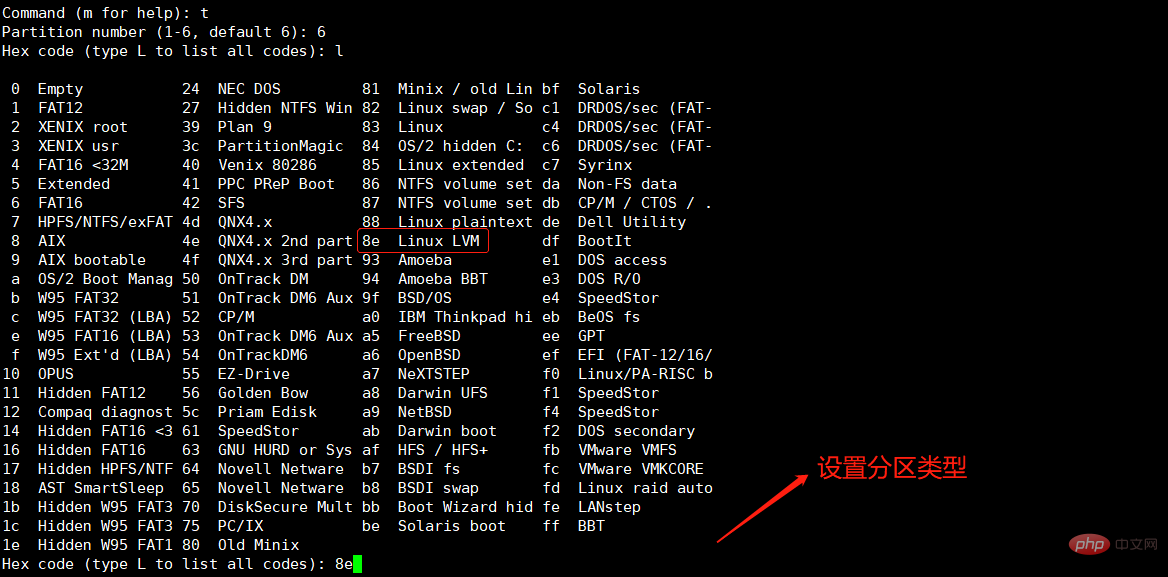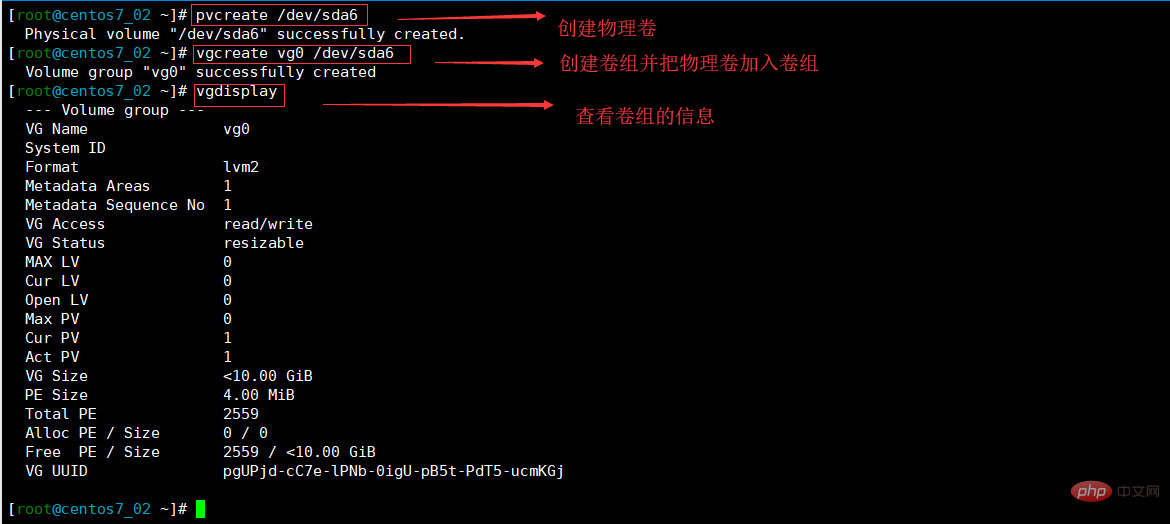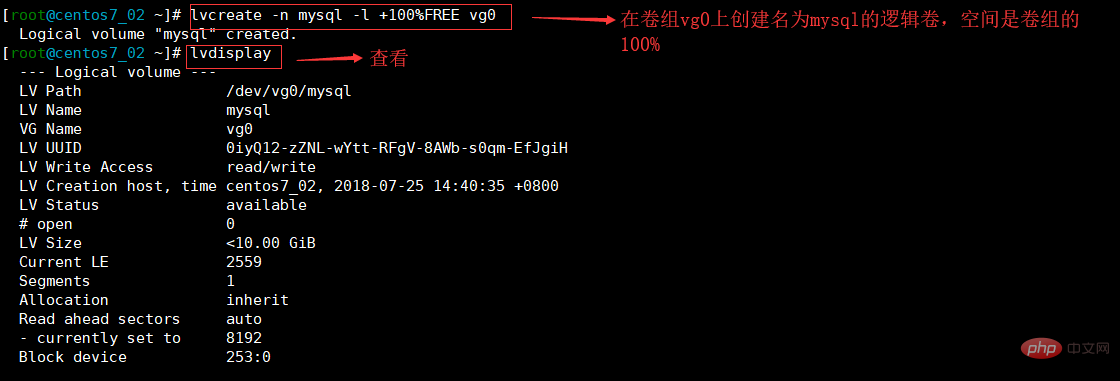How to install MySQL binary
MySQL binary installation method: 1. Download the binary package; 2. Mount the new logical volume to "/data"; 3. Unzip it to the installation directory and view the built-in installation information; 4. Set the configuration file; 5. Specify the database; 6. Service startup script; 7. Perform safe initialization.

The operating environment of this tutorial: CentOS 7 system, mysql version 8, Dell G3 computer.
MySQL Binary Installation
Planning
1. Download the binary package
https: //downloads.mariadb.org/mariadb/10.2.16/
2. Clean logical volume lvm
3. New logical volume Mount to /data
4. Store the database in the /data/mysql directory
5. Unzip to the installation directory and view the built-in installation information
6. Set configuration file
7. Specify database
8. Service startup script
9. Safe initialization
Create a new LVM partition
1, create a new logical volume and set the space
fdisk /dev/sda #



##2. New logical volume type



partprobe
#
#



 ##5. Mount
##5. Mount

vim /etc/fstab # #

mysql安装设置
1、创建mysql账号信息
useradd -r -s /sbin/nologin -d /data/mysql -m mysql # #
![How to install MySQL binary[39] How to install MySQL binary[39]](https://img.php.cn/upload/article/000/000/020/eb7f89f7099cbee44321ba866173f597-12.png)
2、解压mysql二进制文件
![How to install MySQL binary[41] How to install MySQL binary[41]](https://img.php.cn/upload/article/000/000/020/eb7f89f7099cbee44321ba866173f597-13.png)
备注:必须解压到/usr/local目录下
3、创建mysql软连接
![How to install MySQL binary[43] How to install MySQL binary[43]](https://img.php.cn/upload/article/000/000/020/826222e729197585205e9fd6a28e5b8e-14.png)
4、修改mysql目录下所有的权限
![How to install MySQL binary[45] How to install MySQL binary[45]](https://img.php.cn/upload/article/000/000/020/96faac6046b04c3c65ab5861884c11c0-15.png)
5、把执行文件bin放入 $PATH全局变量
vim /etc/profile.d/mysql.sh
#
#
![How to install MySQL binary[47] How to install MySQL binary[47]](https://img.php.cn/upload/article/000/000/020/d03015a83e32cacb50d0a87ce71442d0-16.png)
让设置生效
. /etc/profile.d/mysql.sh # #
6、生成数据库文件
scripts/mysql_install_db --datadir=/data/mysql --user=mysql # #
![How to install MySQL binary[49] How to install MySQL binary[49]](https://img.php.cn/upload/article/000/000/020/d03015a83e32cacb50d0a87ce71442d0-17.png)
7、编辑mysql配置文件
![How to install MySQL binary[51] How to install MySQL binary[51]](https://img.php.cn/upload/article/000/000/020/c33c6ea11eda402d4fab181e5bb73260-18.png)
备注:图上是复制配置模板覆盖原来的文件,根据环境来选着不同的模板文件
vim /etc/my.cnf # #
![How to install MySQL binary[53] How to install MySQL binary[53]](https://img.php.cn/upload/article/000/000/020/0f98c84943756c6a515a0d29fa8caa53-19.png)
备注:要注意这里数据库路径一定要和上面指定的存放数据库文件的路径一致
启动文件
1、把mysql启动文件放入init.d
![How to install MySQL binary[55] How to install MySQL binary[55]](https://img.php.cn/upload/article/000/000/020/0f98c84943756c6a515a0d29fa8caa53-20.png)
2、加入启动列表
![How to install MySQL binary[57] How to install MySQL binary[57]](https://img.php.cn/upload/article/000/000/020/a302b749e4e5e50809c84e8af7e7034e-21.png)
2、启动服务
service mysqld start # #
备注:如果启动失败,注意检查权限和路径
到这mysql是可以登入了,但是现在随便一个用户都可以登入,无需密码验证,这样太不安全,下面简单的加固下
安全加固
mysql_secure_installation # #
![How to install MySQL binary[59] How to install MySQL binary[59]](https://img.php.cn/upload/article/000/000/020/71c8c3d05efa65e07a7af890ebf468e6-22.png)
![How to install MySQL binary[61] How to install MySQL binary[61]](https://img.php.cn/upload/article/000/000/020/70c5d657103f0a98fb6791518e251504-23.png)
结果
指定root用户 –p 输入密码登陆【推荐学习:mysql视频教程】

The above is the detailed content of How to install MySQL binary. For more information, please follow other related articles on the PHP Chinese website!

Hot AI Tools

Undresser.AI Undress
AI-powered app for creating realistic nude photos

AI Clothes Remover
Online AI tool for removing clothes from photos.

Undress AI Tool
Undress images for free

Clothoff.io
AI clothes remover

Video Face Swap
Swap faces in any video effortlessly with our completely free AI face swap tool!

Hot Article

Hot Tools

Notepad++7.3.1
Easy-to-use and free code editor

SublimeText3 Chinese version
Chinese version, very easy to use

Zend Studio 13.0.1
Powerful PHP integrated development environment

Dreamweaver CS6
Visual web development tools

SublimeText3 Mac version
God-level code editing software (SublimeText3)

Hot Topics
 MySQL: An Introduction to the World's Most Popular Database
Apr 12, 2025 am 12:18 AM
MySQL: An Introduction to the World's Most Popular Database
Apr 12, 2025 am 12:18 AM
MySQL is an open source relational database management system, mainly used to store and retrieve data quickly and reliably. Its working principle includes client requests, query resolution, execution of queries and return results. Examples of usage include creating tables, inserting and querying data, and advanced features such as JOIN operations. Common errors involve SQL syntax, data types, and permissions, and optimization suggestions include the use of indexes, optimized queries, and partitioning of tables.
 MySQL's Place: Databases and Programming
Apr 13, 2025 am 12:18 AM
MySQL's Place: Databases and Programming
Apr 13, 2025 am 12:18 AM
MySQL's position in databases and programming is very important. It is an open source relational database management system that is widely used in various application scenarios. 1) MySQL provides efficient data storage, organization and retrieval functions, supporting Web, mobile and enterprise-level systems. 2) It uses a client-server architecture, supports multiple storage engines and index optimization. 3) Basic usages include creating tables and inserting data, and advanced usages involve multi-table JOINs and complex queries. 4) Frequently asked questions such as SQL syntax errors and performance issues can be debugged through the EXPLAIN command and slow query log. 5) Performance optimization methods include rational use of indexes, optimized query and use of caches. Best practices include using transactions and PreparedStatemen
 How to connect to the database of apache
Apr 13, 2025 pm 01:03 PM
How to connect to the database of apache
Apr 13, 2025 pm 01:03 PM
Apache connects to a database requires the following steps: Install the database driver. Configure the web.xml file to create a connection pool. Create a JDBC data source and specify the connection settings. Use the JDBC API to access the database from Java code, including getting connections, creating statements, binding parameters, executing queries or updates, and processing results.
 Why Use MySQL? Benefits and Advantages
Apr 12, 2025 am 12:17 AM
Why Use MySQL? Benefits and Advantages
Apr 12, 2025 am 12:17 AM
MySQL is chosen for its performance, reliability, ease of use, and community support. 1.MySQL provides efficient data storage and retrieval functions, supporting multiple data types and advanced query operations. 2. Adopt client-server architecture and multiple storage engines to support transaction and query optimization. 3. Easy to use, supports a variety of operating systems and programming languages. 4. Have strong community support and provide rich resources and solutions.
 How to start mysql by docker
Apr 15, 2025 pm 12:09 PM
How to start mysql by docker
Apr 15, 2025 pm 12:09 PM
The process of starting MySQL in Docker consists of the following steps: Pull the MySQL image to create and start the container, set the root user password, and map the port verification connection Create the database and the user grants all permissions to the database
 MySQL's Role: Databases in Web Applications
Apr 17, 2025 am 12:23 AM
MySQL's Role: Databases in Web Applications
Apr 17, 2025 am 12:23 AM
The main role of MySQL in web applications is to store and manage data. 1.MySQL efficiently processes user information, product catalogs, transaction records and other data. 2. Through SQL query, developers can extract information from the database to generate dynamic content. 3.MySQL works based on the client-server model to ensure acceptable query speed.
 Laravel Introduction Example
Apr 18, 2025 pm 12:45 PM
Laravel Introduction Example
Apr 18, 2025 pm 12:45 PM
Laravel is a PHP framework for easy building of web applications. It provides a range of powerful features including: Installation: Install the Laravel CLI globally with Composer and create applications in the project directory. Routing: Define the relationship between the URL and the handler in routes/web.php. View: Create a view in resources/views to render the application's interface. Database Integration: Provides out-of-the-box integration with databases such as MySQL and uses migration to create and modify tables. Model and Controller: The model represents the database entity and the controller processes HTTP requests.
 How to install mysql in centos7
Apr 14, 2025 pm 08:30 PM
How to install mysql in centos7
Apr 14, 2025 pm 08:30 PM
The key to installing MySQL elegantly is to add the official MySQL repository. The specific steps are as follows: Download the MySQL official GPG key to prevent phishing attacks. Add MySQL repository file: rpm -Uvh https://dev.mysql.com/get/mysql80-community-release-el7-3.noarch.rpm Update yum repository cache: yum update installation MySQL: yum install mysql-server startup MySQL service: systemctl start mysqld set up booting






